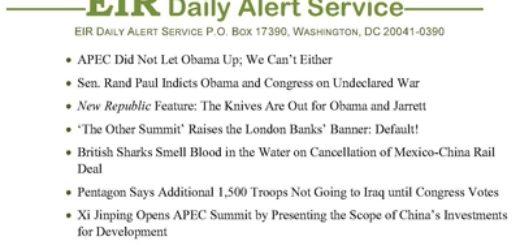EIR Daily Alert Service (Late Posting) July 18, Tues.
|
TUESDAY, JULY 18, 2017 Volume 4, Number 141 EIR Daily Alert Service P.O. Box 17390, Washington, DC 20041-0390
EDITORIALReject the Fools Pushing ‘Russia-Gate’; It’s the Economy, Stupid!July 17 (EIRNS)—If there were “traitors” to the survival of the United States, they would be but the politicians and media continuing to push a crazed “Russia-gate” coup attempt against President Trump for his policy of cooperating with Russia and China. If that strategic peace policy of the President is destroyed, the result will be spreading wars, and potentially war of nuclear powers. Even if the worst were avoided, the fact is that in the Bush-Obama era of regime-change wars—permanent war—the United States has been undergoing economic, social and cultural destruction. Trump is trying to end that disastrous era through cooperation with Presidents Putin and Xi, and is following a clearly successful course. Moreover, he is determined to continue to pursue it in spite of the cries of “impeachment” and the threats of the intelligence agencies and their British intelligence mentors. But the United States could also be destroyed by the financial crash and economic collapse threatening now, as bubbles collectively larger than those of 2007 are defaulting. The United States economy is sinking, and above all because its decrepit economic infrastructure is falling apart with no repairs, let alone replacement at a higher level of technology. In that situation, what does it mean for some political leaders to say, “Don’t offer any alternative policies to the American people; just impeach—and prosecute!—the President for meeting with Russians.” This is a recipe for chaos. It is the economy, stupid, and the condition of the U.S. economy—of employment, of productivity, of quality of life—is sinking fast. Here the American people have to “take over” President Trump’s derailed plans to “make America great again.” It is up to us to defeat the Wall Street banks which have pushed him out of the driver’s seat. The “American System of economy” is what he has spoken for. He has not implemented it. It is what we need to save this nation, so we must carry the President to implementing it. EIR Founding Editor Lyndon LaRouche has stated that American System in four policy actions that must be taken now, starting with reinstating the Glass-Steagall Act to “drive the money-changers from the temple of our civilization,” as FDR said. The lessons of the Apollo Project must be applied to expanded space exploration and to the renewal and rebuilding of America’s economic infrastructure at new levels of technology. The goal of developing fusion energy must be made the crash program it never became. The American System can return us to the “golden age of U.S. productivity” which began with FDR and ended soon after JFK was assassinated; and which resulted from the almost continuous renewal of U.S. economic infrastructure at advancing levels. Or we can face strategic crisis and war if we let the economy collapse. Ignore the “Russia-gaters”; this is the issue. COLLAPSING WESTERN FINANCIAL SYSTEMDo You Think the U.S. Won’t Have a New Financial Collapse Soon?July 17 (EIRNS)—Signs of growing defaults are showing across the range of ultimately unpayable debt bubbles in the United States economy, while underlying economic growth continues in the crater of a 1.5% nominal GDP annual rate. The July 17 Wall Street Journal featured a report of an “unheard of event”—a Houston-based private equity fund once “worth” more than $2 billion, is now worth zero. Even following the report in the July 11 Houston Chronicle that defaults throughout Texas corporations are shooting up and exceed even 2009 economic collapse levels, securities funds of this size losing all their value remains “unheard of”; 25% maximum losses are typical when large PE funds go bust. Yet, the Journal quotes one expert, “several other energy-focused funds are in danger of doing so.” Big losers in the evaporation of $2.1 billion EnerVest Ltd. include Canada’s second-largest pension fund, the Teamsters Western Conference Pension Fund, various high-roller charitable foundations like Getty Trust, MacArthur Foundation; and Wells Fargo bank, which loaned EnerVest Ltd. $1.3 billion to leverage its investments in oil securities. In the consumer debt bubble, auto loan (90-day) delinquencies have reached just under 4% (3.96%) for all $1.3 trillion of auto loans, comparable to the mortgage sector in late 2006. Bloomberg News today reports on growing fraud in auto lending, as well as lax to non-existent underwriting standards, as well as spreading securitization of payments (and thus of defaults) in the entire sector. The volume of both auto and mortgage lending is dropping as the biggest banks head for the exits, according to a separate report in Credit Union Times. The falling economy is making tax revenues sink. Some 33 states reported shortfalls in projected revenues in their fiscal year 2017, which ended June 30. This was similar to the budget-collapse year 2010. But less publicized has been the fact that the Federal government deficit is ballooning this Federal fiscal year 2017 (which ends Sept. 30) because of much lower tax revenues than expected, as well as forced restatement of the value of student debt—because of mass defaults and delinquencies—which counted as a loss of nearly $90 billion for the Federal government in June. What Makes Productivity Grow?July 17 (EIRNS)—The period from the mid-1920s to 1970 is called by many economic historians the “golden age of American productivity.” A 2016 book, The Rise and Fall of American Growth: The U.S. Standard of Living since the Civil War, by the very well-known Northwestern University economist Robert J. Gordon, documents very ably the special nature of this period in the transformation of American economic activity by the spread of industrial electricity, the internal combustion engine, and telecommunications. On the basis of these and other inventions, Gordon traces the growth of what is called total factor, or multi-factor, productivity. This is economic growth not accounted for by applying more capital, more labor, or more educated labor, but by the greater efficiency with which industry uses all three of the above—caused by technological advance, including the use of technologies not previously present in the industrial sector at all. While showing that productivity growth has progressively abandoned the Western industrialized economies since 1970, and accurately downplaying the effects of “Internet age” inventions, Professor Gordon unaccountably does not focus on the role of new infrastructure based on new technological advances. Thus, he does not credit NASA or the Manhattan Project with contributing to U.S. overall productivity. But a thorough report on total factor productivity (TFP), by the National Bureau of Economic Research (NBER), found the following. The decade of most rapid total factor productivity growth in U.S. history, by a significant margin, was the 1930s—not the war-mobilization 1940s, though that was second best. What caused the extraordinary 3.3% average annual TFP growth in the 1930s? “This was due to the very strong growth in electric power generation and distribution, transportation, communications, civil and structural engineering for bridges, tunnels, dams, highways, railroads and transmission systems; and private research and development.” This was the 2005 NBER Report, “Sources of TFP Growth in the Golden Age.” Such great infrastructure projects as FDR’s “Four Corners” challenge industry to spread technological progress in order to build them; a phenomenon being seen in China’s building of extraordinary bridges, fully automated ports, high-speed rail lines through deserts and over the world’s highest mountain ranges, etc. A later 2014 NBER report estimated that TFP in China’s economy grew at 3.1% annually from 1998-2011. THE NEW GLOBAL ECONOMIC ORDERChina Investment Corp. Again Looks to U.S. InfrastructureJuly 17 (EIRNS)—Economic growth figures for China’s economy were reported today by its Commerce Department, with second-quarter GDP reported 6.9% above the second quarter of 2016. Industrial production grew by 7.6%, fixed-asset capital investment by 8.5%, and consumer spending by 11%. China’s growth in 2017 will be faster than in the previous year, for the first time since 2010; and that, with the government clamping down on real estate bubbles and shadow banks. China Investment Corp. (CIC) is a sovereign wealth fund investing about $800 billion, based on China’s foreign exchange reserves, which currently total about $3.1 trillion. CIC recently moved its North American offices to New York. The New York Times quoted CIC Managing Director Liu Fangyu’s statement on July 11, requested more openness to its investments in the United States. “We hope that the U.S. government will provide us with a more liberal, equal and non-discriminatory investment environment,” Liu said. “The fund is particularly focused on infrastructure.” The CIC’s previous managing director, Ding Xuedong, had said in a January speech in Hong Kong that CIC wanted to reinvest some or all of its assets currently in U.S. Treasury securities, into an “infrastructure build” in the United States. Ding had estimated that a real renewal of the United States’ economy’s decrepit infrastructure would require a whopping investment of $8 trillion. Ding’s Jan. 16, 2017 remarks to the Asian Financial Forum in Hong Kong were carried in the South China Morning Post; and, according to today’s New York Times, in a China government publication simply called The Paper. The Times reported that CIC currently has $90 billion invested in United States, “mostly in the financial markets.” This refers primarily to $60 billion in U.S. Treasuries. Most of the Times article, unfortunately, concerns attempts or intents to block such investment by China, in Congress and by some in the Trump Administration. SCIENCE AND INFRASTRUCTUREGlobal Warming? Reports of ‘Record Temperatures’ Come from Data Manipulation, not ScienceJuly 17 (EIRNS)—The American people are bombarded with claims every summer that “this year” is apparently the “hottest year on record” (implying or stating outright that human CO2 emissions must be the cause for this “unprecedented” climate change). However, a new study further demonstrates what EIR presented in its 2015 report, “ ‘Global Warming’ Scare Is Population Reduction, Not Science”—the historical records of global temperatures over the past 100 years have been adjusted to make the past appear cooler, and the present appear warmer (making what are actually natural variations look more extreme). On June 27, three researchers—Dr. Craig D. Idso, founder and current chairman of the Center for the Study of Carbon Dioxide and Global Change; Dr. Joseph S. D’Aleo, meteorologist, first Director of Meteorology at The Weather Channel; and Dr. James P. Wallace III, statistician—released a report, “On the Validity of NOAA, NASA and Hadley CRU Global Average Surface Temperature Data & The Validity of EPA’s CO2 Endangerment Finding,” demonstrating that the adjustments made to the historical records in the Global Average Surface Temperatures (GAST) dataset make it an unreliable representation of historical reality. “It was found that each new version of GAST has nearly always exhibited a steeper warming linear trend over its entire history…. The conclusive findings of this research are that [GAST data are] not a valid representation of reality. In fact, the magnitude of their historical data adjustments … are totally inconsistent with published and credible U.S. and other temperature data. Thus, it is impossible to conclude from the three published GAST data sets that recent years have been the warmest ever despite current claims of record setting warming.” What is the significance of this GAST database? The GAST historical data provide 90% to 95% of the data going into the historical temperature records produced by NASA, NOAA and the U.K.’s Climate Research Unit Hadley Center—probably the three most cited historical temperature records over this period (the past 100 years). When people claim that NASA, NOAA, and Hadley data all independently show record temperatures, that is a lie: they all come from one database, a database now shown to be “not a valid representation of reality.” The authors intend to send their findings to the Trump Environmental Protection Agency (EPA), which is currently reviewing whether to repeal the 2009 “Endangerment Finding,” in which Obama’s EPA ruling which asserted human CO2 emissions are a pollutant, providing the cover for the EPA to take direct actions against the coal industry, power plants, and other emitters of the plant food known as CO2. Many leading opponents to the climate change scare view the “Endangerment Finding” as a key item to be reversed. These Policy Steps on U.S. Infrastructure Qualify as InsaneJuly 17 (EIRNS)—With transportation infrastructure visibly breaking down in two of the nation’s three largest cities, as well as in the vital Northeast Rail Corridor, the House Transportation/ Housing and Urban Development appropriations bill, reported out of the Appropriations Committee on July 14, eliminated the Federal Transportation Investment Generating Economic Recovery (TIGER) grants completely, from $500 million to zero. The bill, now going to the House floor for a vote, cut the overall budget of the Transportation Department by 8% in absolute terms. TIGER grants are also used to improve port infrastructure; and inland waterway dams and locks are renewed by a Federal loan program through the U.S. Army Corps. of Engineers (ACE), a program cut by 54% in the same appropriations budget. American agriculture exports are beginning to be threatened not by price competition or unfair trade, but by crumbling inland waterway infrastructure, which was given a D+ mark by the American Society of Civil Engineers report card. The Coalition for Americas Gateways and Trade Corridors (CAGTC) on July 14 released its second in a series of white papers that describes the decline of national freight infrastructure. Called “The Vital Role of U.S. Transportation Infrastructure in Moving Agriculture Forward,” reviews the impact of deteriorating infrastructure on U.S. agricultural competitiveness, focusing on soybeans grown in Illinois and Iowa. There has just been a very large sale of soybeans to China, but 58% of soybeans pass through locks on the Illinois, Ohio and Mississippi Rivers and leave the United States through Gulf of Mexico ports. “More than half of the locks are over 50 years old. The LaGrange Lock on the Illinois River is 80 years old, with concrete crumbling and other critical components difficult to maintain…. “Between 2000 and 2014, the average delay per lock nearly doubled and … 49% of vessels experienced delays in 2014,” which has grown since. The backlog of inland waterway maintenance to be done by the Army Corps keeps growing—it is now at $600 million—and the time to schedule and make a major renovation and replacement has grown to decades. Meanwhile, renewing city and town water infrastructure across the United States requires at least $50 billion in annual spending over decades; but Federal funding for it is just 25% of what it was 40 years ago, in real terms. A $500 million loan fund for rural towns is likely to be eliminated by Congress this year. So 48 public water/sewer utilities were sold to private companies in 2015; 53 more in 2016; 23 more in the first quarter of 2017. U.S. POLITICAL AND ECONOMICHell’s Ninth Circle: Fire Causes Monday Morning Manhattan Subway ChaosJuly 17 (EIRNS)—The second Monday of the “Summer of Hell” for New York public transit users only saw things get worse—far worse. New York’s Metropolitan Transit Authority (MTA) was forced to completely suspend service on two heavily travelled subway lines and temporarily suspend it on two others at the height of the Monday morning commute, when a trash littered along the tracks caught fire and spread smoke into a subway tunnel at 145th Street, threatening passengers and train safety. The New York Fire Department reports that “rubbish” along the tracks in upper Manhattan near 145th Street caught fire at 7:30 this morning, spreading smoke inside the tunnel, forcing MTA to suspend train service both into and out of the city for two hours, until the fire could be extinguished and emergency crews cleared. Passengers were stranded on trains without lights and air conditioning, as power was cut to the lines as a precaution. Although there were no fatalities, unlike a similar incident in Washington, D.C., when one passenger died from smoke inhalation, nine passengers were taken to hospitals and dozens were treated on the scenes. Personal video shared from terminals revealed the chaotic scenes as stranded riders—in trains already overcrowded because of track repair at Penn Station—packed platforms and stairways at stations above and below 145th Street, and flocked to buses that took them to the #1 line, the only nearby line going into the city. The problem of “track fires” has plagued the MTA for years, becoming so serious that last year MTA was forced to start an operation called “Track Sweep” to address the problem. According to figures, there were 981 subway fires reported between May 2016 and April 2017, which is 36 more fires than the 945 fires during the prior 12-month period. Fires caused 844 train delays in April this year, an increase from the 689 trains delayed by fires in the subway system during April 2016. The ongoing breakdown of the New York City system is not touched by renovating Penn Station! The entire system clearly needs to be rebuilt. STRATEGIC WAR DANGERSouth Korea Proposes Inter-Korean Talks at Defense Minister LevelJuly 17 (EIRNS)—The South Korean government has proposed holding talks with North Korea on Friday, July 21, at the level of defense ministers in an effort to reduce military tensions between the two sides, reports the Korea Herald. “In order to suspend hostile activities at the military demarcation line, we propose holding an inter-Korean military talk at Tongilgak,” the North Korean building inside the Panmunjom truce village in the demilitarized zone, the Defense Ministry said in a statement issued this morning. The ministry asked North Korea to respond by restoring the two Koreas’ military communication line in the West Sea. The North has not yet issued an official statement in response. The Korea Herald further reports that the proposal is designed to follow up on President Moon Jae-in’s offer—made in Berlin on July 6—to suspend “all acts of hostile activities” at the cross-border region as of July 27, when the two Koreas mark the 64th anniversary of the armistice treaty that ended the Korean War in 1953. China has endorsed the South Korean proposal. TASS reported that Chinese Foreign Ministry spokesman Lu Kang told reporters this morning, “We hope that both sides will move in a positive direction to create conditions for breaking the deadlock and resuming dialogue and talks. We also hope that the international community will understand and support constructive efforts of both parties. China will provide the necessary assistance.” French President Praises Talks with Putin for Advances in Syria Peace ProcessJuly 17 (EIRNS)—Commenting on how his late May discussions with Russian President Vladimir Putin in Versailles are helping both countries to resolve the war in Syria, French President Emmanuel Macron said: “After the negotiations with the Russian President in Versailles, I state that we are moving forward on both these issues. Cooperation between our special services on the ground has been raised to a completely different level than before.” In an interview with Journal du Dimanche on July 16, Macron continued: “I’m set to hold a tough position on anyone’s use of chemical weapons in Syria. In the event that this happens, I have ensured that France actually gives a prompt response to this even before it resorts to words. I also demand that humanitarian aid be provided in order to ensure the salvation of civilians in the battle area. These are my two red lines on the Syrian dossier,” Macron said, reported TASS. “Vladimir Putin is an ally of Bashar Assad, while I hold the position that I do not consider the removal of Bashar Assad from power as an obligatory condition for any further initiatives on Syria,” the French President said. “But at the same time I am looking for those measures that would allow for restoration in that region while putting an end to terrorism,” he told JDD. “This is the difference in the position with my predecessor in the Presidential post,” said Macron, referring to former French President François Hollande. |
|
|















